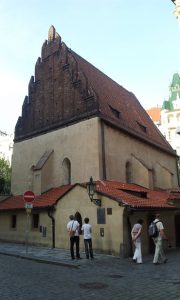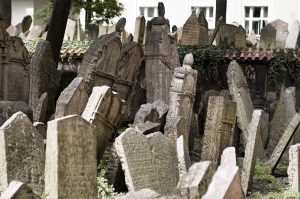Prague’s Jewish Town
By Tracy A. Burns
Introduction
 The experience of visiting Prague’s Jewish Town (named Josefov in Czech after Emperor Josef II) will grip your heart. This is the borough that Gustav Meyrink’s Golem – a robot-like being made of clay – trekked through, a protector of the Jews who became their enemy until stopped by his creator, Rabbi Loew. The plight of the Jews across the centuries becomes almost tangible, given that most of the area is made up of the Jewish Museum which includes four synagogues and a cemetery.
The experience of visiting Prague’s Jewish Town (named Josefov in Czech after Emperor Josef II) will grip your heart. This is the borough that Gustav Meyrink’s Golem – a robot-like being made of clay – trekked through, a protector of the Jews who became their enemy until stopped by his creator, Rabbi Loew. The plight of the Jews across the centuries becomes almost tangible, given that most of the area is made up of the Jewish Museum which includes four synagogues and a cemetery.
History
When the Lesser Town’s Jewish section was destroyed in the 11th century, Jews took refuge in the area near the Old Town. Between the 14th and 18th centuries, they suffered through pogroms, destructive fire, and expulsion from Prague. But there were good times as well. From 1597 to 1609 Jehuda Loew ben Bezalel, commonly called Rabbi Loew, was a much respected chief rabbi of Prague who even met with Emperor Rudolf II. Under Emperor Josef II, Jews enjoyed some freedoms and even more after the 1848 revolution, when they received equal rights and were allowed to live where they chose, which resulted in many leaving the Jewish Town. The biggest tragedy occurred during World War II when three-fourths of the Jews in Bohemia and Moravia met their deaths in extermination camps. Many of those who survived emigrated during totalitarian rule.
Prague Jewish Cemetery
 One of the most moving sights in Prague is the Old Jewish Cemetery, where 12,000 crooked
One of the most moving sights in Prague is the Old Jewish Cemetery, where 12,000 crooked
tombstones pile on top of each other, and about 100,000 bodies lie in the cramped space. It served as the Jews’ burial ground from 1439 to 1787. Some headstones are decorated with sculptures or poetry. The oldest one belongs to Avigdor Karo, once the chief rabbi and a poet serving King Wenceslas IV. Rabbi Loew’s tombstone is here too, as is that of the only woman to have a headstone here.
Old New Synagogue
The oldest synagogue in Central Europe and one of Prague’s earliest Gothic buildings, the Old-New Synagogue was built in 1270. Rabbi Loew’s chair remains empty. A red-gold banner resembles the one presented to the Jews here by Emperor Charles IV in 1357. Notice the wine leaf motifs on the synagogue’s tympanum. This magical place is also wreathed in legends: In The Golem, Rabbi Loew hides the artificial human in the synagogue’s attic. Some say the Golem is still there.
Maisel Synagogue
The Maisel Synagogue and the Spanish Synagogue house permanent exhibitions of Jewish history in Bohemia and Moravia. The Maisel Synagogue takes the visitor from settlement to emancipation while the Spanish Synagogue depicts the 18th, 19th, and 20th centuries. Built-in the 16th century, parts retain the original Renaissance décor while most are Neo-Gothic in design. During World War II it served as a warehouse for the treasures that Adolf Hitler planned to exhibit in his Museum of the Extinct Jewish Race. Erected in 1868, the Spanish Synagogue has a Moorish look as well as stained glass windows. The upper floor houses an exhibition of silver. The author of the Czech national anthem, František Škroup, was the synagogue’s first organist (1836-1845).
Pinkas Synagogue
Constructed in 1479 by Rabbi Pinkas, the Pinkas Synagogue is a memorial to the 77,297 Czech Jews who died in Nazi camps. The walls are filled with their handwritten names and other information. On the east wall is a list of concentration camps. The synagogue has experienced difficult times. When the Communists took control, the synagogue was closed and the names were erased. It was only reopened in 1994. Then it was closed for a short time after the 2002 floods. The upper floor consists of an exhibition of children’s artwork from the Theresienstadt (Terezín) concentration camp.
Ceremonial Hall
The Ceremonial Hall, a Neo-Romanesque mortuary house, contains a Jewish Customs and Traditions exhibition.
Klausen Synagogue
The Klausen Synagogue, from 1694 and Baroque in style, also covers this theme. The Jewish Town Hall, while not open to the public, boasts a Rococo façade from the 18th century.
Non-Jewish Sights in the former Jewish Ghetto
The non-Jewish sights in the quarter are also enticing.
Convent of St. Agnes of Bohemia
The convent was established in the 13th century with Agnes as the first abbess and became Prague’s first hospital. The oldest early Gothic complex in Bohemia is now home to a comprehensive medieval art exhibition containing pieces from all over Central Europe.
Museum of Decorative Arts
The Museum of Decorative Arts enthralls with its permanent exhibition of tapestries, glasswork, porcelain, furniture, and more. Erected from 1897 to 1900 in Neo-Renaissance style, the building’s interior is decorated with wall paintings, stained glass Corinthian pilasters, and Tuscan columns.
Rudolfinum
Home to the Czech Philharmonic and to space for temporary art exhibitions, the Neo-Renaissance, 19th century Rudolfinum served as Parliament during the interwar years. It is remarkable for its statuary.
Faculty of Philosophy, Charles University
On the wall of Charles University’s building is a plaque commemorating Jan Palach, who set himself on fire in January of 1969, to protest against the 1968 Warsaw Pact invasion. His death mask juts out from the background on which only his name and date of death are engraved.
Faculty of Law, Charles University
Take a look at Charles University’s Law Faculty nearby. Constructed from 1921 to 1931, it was designed by renowned Czech architect Jan Kotěra and served as SS headquarters during World War II.



